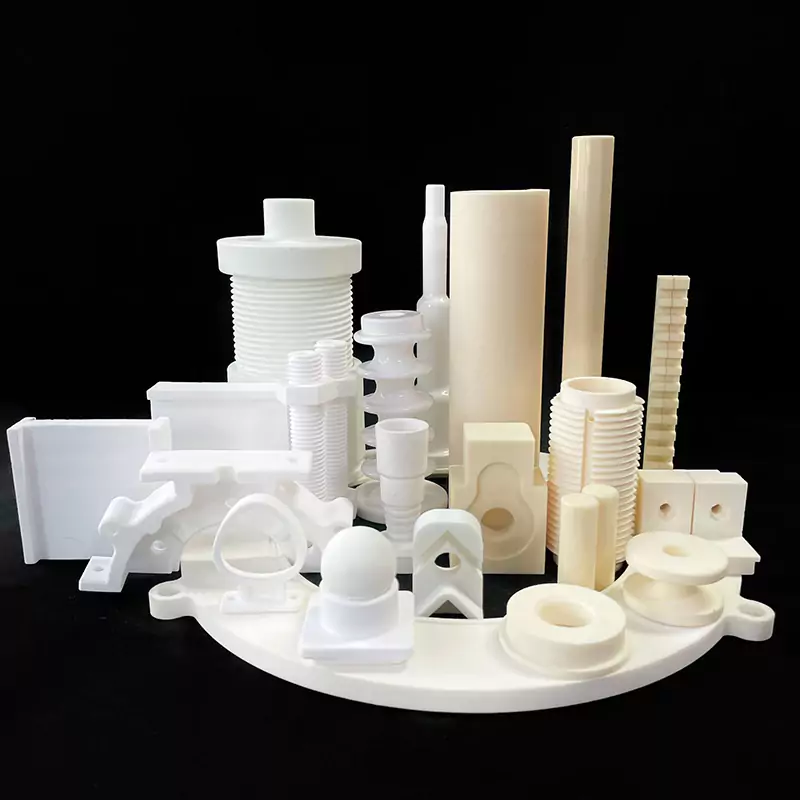1. Applications in daily-use ceramics:
Rare earth elements are utilized in daily-use ceramics as ceramic pigments. The primary industrial application of rare earth ceramic pigments is the use of praseodymium yellow for bright, pure yellow ceramic tile glazes. This color remains stable even at temperatures as high as 1000℃ and can be employed in both single and double firing processes. It has captured a significant portion of the market previously dominated by expensive tin yellow glazes. Italy, one of the countries with the world’s largest tile industry, is among the largest users of praseodymium oxide (ZrO2-Pr6O11-SiO2) for producing bright, pure yellow ceramic glazes.
The addition of rare earth elements makes the glaze very glossy. Cerium oxide is used as a white opacity agent in enamelware. Applying a layer of glaze containing 25% cerium oxide on a ceramic base coat and then firing it at 900℃ results in a warm white color compared to traditional opacity agents. In the double firing process, cerium oxide is finely ground and added to the glaze along with other coloring oxides to enhance the brightness of the ceramic’s color. Cerium oxide serves as a white opacity agent in enamelware, yttrium oxide is used in orange ceramic pigments, and neodymium oxide yields a light purple color in ceramic pigments.
2. Applications in Advanced Ceramics:
With the advancement of science and technology, high-tech sectors such as electronics, information technology, energy, aerospace, marine engineering, and military applications have demanded new materials, giving ceramics a new lease of life and forming a new domain known as advanced ceramics, also termed as fine ceramics. Advanced ceramics, which are an evolution from the ceramics used in industry, involve adjusting raw materials, controlling chemical compositions, refining manufacturing processes, and managing the microstructure and material properties to create ceramics with specific and desired characteristics.
The categories of advanced ceramics are extensive, broadly categorized into functional ceramics and high-temperature structural ceramics. Structural ceramics are primarily used for their advanced mechanical properties in producing various mechanical structural components. On the other hand, functional ceramics leverage their unique electrical, magnetic, acoustic, optical, and other properties to create capacitive ceramics, magnetic ceramics, piezoelectric ceramics, conductive ceramics, electro-optical ceramics, and more.
Typically, rare earth elements are not the primary components in ceramics; rather, they are used as additives. The application of rare earth oxides in advanced ceramics mainly serves as additives to improve the sintering, density, microstructure, and phase composition of ceramics. This enhancement aims to meet the quality and performance requirements of ceramics used in diverse scenarios.

(1) Primary Classifications of Advanced Ceramics:
① Structural Ceramics:
The addition of rare earth elements to silicon nitride ceramics is considered one of the most promising high-temperature structural materials. This material has been successfully employed in engine components such as cylinder liners, piston heads, turbine blades, highly wear-resistant nozzles, cutting tools, and bearings. More than 20 manufacturers in the Western world produce sintered silicon nitride, with eight each in the United States and Japan.
Another widely used rare earth-added ceramic is yttria-stabilized zirconia, a new type of structural ceramic developed in the 1970s. By incorporating rare earth elements, partially stabilized zirconia is produced, which is significantly tougher than fully stabilized zirconia. There are 24 manufacturers globally producing this ceramic, primarily in countries like Japan, the United States, and the United Kingdom. It has found extensive applications in thermal barrier coatings, oxygen sensors, thermistors, high-temperature fuel cells, and synthetic gems.
② Functional Ceramics:
Rare earth elements find applications in various functional ceramics such as ceramic capacitors, conductive ceramics, electro-optical ceramics, and variable resistors. The addition of rare earth elements, mainly lanthanum or neodymium, to ceramic capacitors allows for stable dielectric constants across a wide temperature range, thereby enhancing their operational lifespan. Conductive ceramics, like lanthanum chromite ceramics, retain stability even at 1900℃ in an oxidizing environment and can be used as heating elements, with potential applications in fuel cells. Electro-optical ceramics are materials that alter their optical properties in response to electrical signals. In areas requiring optical signal control, especially in fiber optic communication devices, the use of electro-optical ceramics, typically with about 10% lanthanum added to PLZT ceramics, has been increasingly significant. The addition of rare earth elements notably improves PLZT ceramics’ performance, most significantly enhancing their light transmittance from 67% to 98%.
(2) Current Development of Advanced Ceramics:
According to analyses by the United States Geological Survey, the sales of advanced ceramics were estimated between $7 to $11 billion in 1995 and between $5.9 to $20 billion in 2000. The Commerce Communications Corporation estimated the total U.S. market for advanced ceramics at $4.295 billion in 1995 and $6.422 billion in 2000. However, ceramics incorporating rare earth elements still represent only a small fraction, estimated at less than 10%.
Japan faces a significant scarcity of rare earth resources, yet it remains at the forefront of rare earth applications and development, including their use in functional and structural ceramics. Japan holds a leading position in rare earth-related inventions for ceramics, especially in electronic ceramics, accounting for over 40% of patents. While the overall level of functional ceramics research and development in the United States and Western Europe lags behind Japan, their research in ceramic sensors is highly advanced, with many outcomes being utilized in military applications. Additionally, rare earths are extensively used as sintering aids and stabilizers in structural ceramics.
In China, the Institute of Silicate Chemistry at the Chinese Academy of Sciences in Shanghai conducts significant research on functional and structural ceramics. Other institutions such as Tsinghua University, Shandong University, and the Institute of Metal Research at the Chinese Academy of Sciences in Shenyang are also engaged in similar research. However, overall, China is still tracking the development of advanced ceramics worldwide and lags behind Japan and the United States in terms of technology and innovation in this field.
